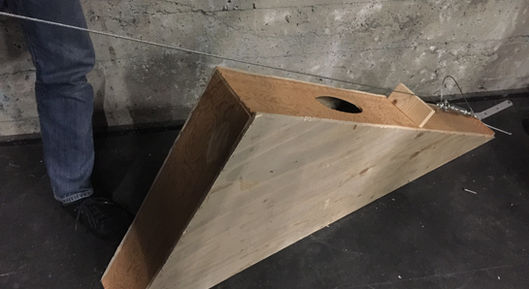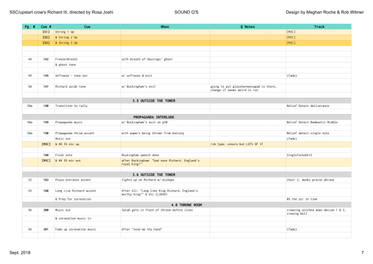Richard III
Seattle Shakespeare Company/upstart crow collective, September 2018
Co-Sound Design with Robertson Witmer
Director: Rosa Joshi
Choreographer: Alice Gosti
Lighting Design: Geoff Korf
Scenic Design: Shawn Ketchum Johnson
Costume Design: Christine Tschirgi
Props Design: Robin Macartney
One of the most challenging and rewarding shows I've done to date was a highly stylized, all-femme production of Richard III, set from the start to exist in a design world that was dark, harsh, and fascist. It was a follow-up to a 2-part production of Henry VI that I assistant-designed in January of 2017 called Bring Down the House another all-female production that featured choreographed taiko drumming for the battles. It was an incredible show & a fantastic experience, especially because I got to flex some design muscles quite a bit more than when assisting previously
. While the company had not originally intended to produce Richard III when doing the Henry VI cycle, it became clear within the first week of having both shows open that audiences would not just welcome it, they clamored for it.
Because the original sound designer wasn't available for the majority of tech for Richard III but had already laid so much groundwork for the show, I became co-sound designer. During the pre-production and rehearsal process, Rob did the bulk of the back-end R&D on the system that would eventually amplify the set itself (aircraft cables stretched diagonally across the set with "resonators" at the bases, plucked and played throughout the show via contact microphones) and curated much of the musical palette we used for the show's many forceful, driving scene shifts. We both attended production meetings, met with the director, and recorded the actors for playback during the show's surreal & ghostly moments, and I built the sound cue sheet and started pulling clips, soundscapes, and music based off of the work we had done so far.
When we got into tech, I had the challenge of, for the first time, not being able to program for myself even via screen-share. It got frustrating at times because while I knew in my head the quick adjustments & etc. I wanted to make in the QLab window, translating that knowledge into words for someone else to implement took time I was not used to needing. It was a big show, sound-wise, and I used just about every second of time I could to fine-tune the details and make sure the more complicated cue sequences worked the way I wanted them to. Luckily, I had prepped plenty and our sound engineer was excellent at tracking the "string moments" (times we wanted the contact mics on each of the 3 wired up resonators active or muted to hear either the metallic pluck of the string or the drumming of the boxes themselves by our ensemble percussionist, Aimee) and Rob continued to send in transition edits from the pieces we had selected together--and in the end, it all came together far better than I ever could have expected.
(Please note: while this was a co-design, I selected only sound clips and paperwork that I created myself!)

Richard III Slideshow Trailer

The show's choreographer used the cables and resonators for most of the political deaths in a method visually resembling something in between a hanging and a beheading, followed by a ghostly exit. These cues played with one of those murder sequences immediately before and after intermission, the first with the head drop and lights out, and the next with the top of the act picking up where it left off & the character rising up for their own ghost walk.
This is another cue sequence that I built for Richard III & recorded from the QLab workspace. The bell you hear at the top takes us from the moment of crowning Richard king to a quick shift of a "dumb show" of the murder of the two young princes (no dialogue, only some screams, gasps, etc. onstage).
Like many cues from this show, much of this was pumped through the system's subwoofers so the audience could physically feel the tension present in the scene. Though there was no blood and the scene was staged very stylistically, it was a particularly horrible moment of the show & I wanted neither to play it down or distract the audience from what was happening onstage.
The final battle sequence happened in movements and was ENORMOUS in a way no audio file is ever going to be able to convey. The brief drop in the music here was a moment when all of the fighters were offstage, only to immediately rush on screaming. When Richmond and Richard finally faced off, Richmond dragged his sword across one of the aircraft cables with the shift that plays here at about 00:30.
The "despair and die" section happened with all of the victims of Richard's regime closing in on him, and the pre-recorded whispers were augmented with floor mics positioned for this very moment. We wanted to hear the actors saying it live with this just filling out the sound. The final screech was a nod back to the harsh sound that played with the political murder before and after the intermission break and happened with Richard's body being dragged to the apron of the stage.
CUE SHEET
“...stark and haunting sound design created by Meghan Roche and Robertson Witmer....Gorgeous designs that all interconnect with one another and the tone of this production."
“And sound designers Meghan Roche and Robertson Witmer have amplified the cables to mimic a giant stringed instrument, creating an eerie atmosphere that welcomes intrigue, battle and murder.”
“But while in most productions those deaths are merely spoken of, we get to see them utilizing this angular set that's a series of blocks and steel cables all of which are amplified, thanks to sound designers Meghan Roche and Robertson Witmer, so that every death, march, battle, etc. can be accompanied by percussion on the blocks and playing of the cables like a large stage sized bass. It's a fantastic addition to the creepy nature of the piece that you almost don't even notice is happening on stage the first few times but then glory in its presence throughout. “















